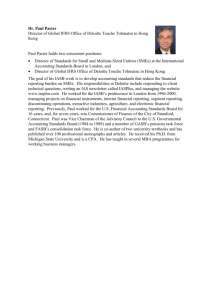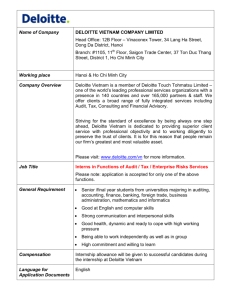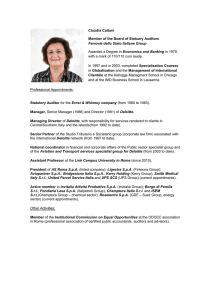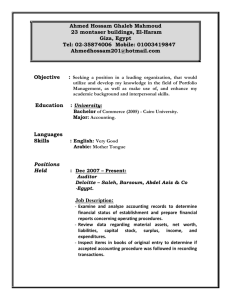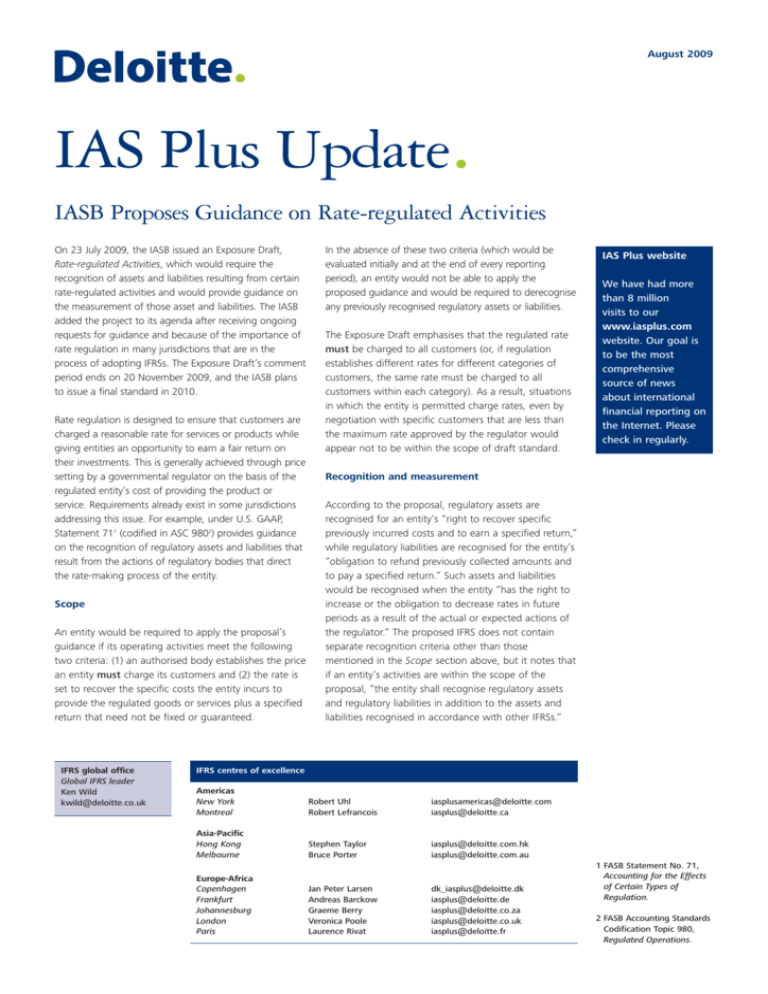
August 2009
IAS Plus Update.
IASB Proposes Guidance on Rate-regulated Activities
On 23 July 2009, the IASB issued an Exposure Draft,
Rate-regulated Activities, which would require the
recognition of assets and liabilities resulting from certain
rate-regulated activities and would provide guidance on
the measurement of those asset and liabilities. The IASB
added the project to its agenda after receiving ongoing
requests for guidance and because of the importance of
rate regulation in many jurisdictions that are in the
process of adopting IFRSs. The Exposure Draft’s comment
period ends on 20 November 2009, and the IASB plans
to issue a final standard in 2010.
Rate regulation is designed to ensure that customers are
charged a reasonable rate for services or products while
giving entities an opportunity to earn a fair return on
their investments. This is generally achieved through price
setting by a governmental regulator on the basis of the
regulated entity’s cost of providing the product or
service. Requirements already exist in some jurisdictions
addressing this issue. For example, under U.S. GAAP,
Statement 711 (codified in ASC 9802) provides guidance
on the recognition of regulatory assets and liabilities that
result from the actions of regulatory bodies that direct
the rate-making process of the entity.
Scope
An entity would be required to apply the proposal’s
guidance if its operating activities meet the following
two criteria: (1) an authorised body establishes the price
an entity must charge its customers and (2) the rate is
set to recover the specific costs the entity incurs to
provide the regulated goods or services plus a specified
return that need not be fixed or guaranteed.
IFRS global office
Global IFRS leader
Ken Wild
kwild@deloitte.co.uk
In the absence of these two criteria (which would be
evaluated initially and at the end of every reporting
period), an entity would not be able to apply the
proposed guidance and would be required to derecognise
any previously recognised regulatory assets or liabilities.
The Exposure Draft emphasises that the regulated rate
must be charged to all customers (or, if regulation
establishes different rates for different categories of
customers, the same rate must be charged to all
customers within each category). As a result, situations
in which the entity is permitted charge rates, even by
negotiation with specific customers that are less than
the maximum rate approved by the regulator would
appear not to be within the scope of draft standard.
IAS Plus website
We have had more
than 8 million
visits to our
www.iasplus.com
website. Our goal is
to be the most
comprehensive
source of news
about international
financial reporting on
the Internet. Please
check in regularly.
Recognition and measurement
According to the proposal, regulatory assets are
recognised for an entity’s “right to recover specific
previously incurred costs and to earn a specified return,”
while regulatory liabilities are recognised for the entity’s
“obligation to refund previously collected amounts and
to pay a specified return.” Such assets and liabilities
would be recognised when the entity “has the right to
increase or the obligation to decrease rates in future
periods as a result of the actual or expected actions of
the regulator.” The proposed IFRS does not contain
separate recognition criteria other than those
mentioned in the Scope section above, but it notes that
if an entity’s activities are within the scope of the
proposal, “the entity shall recognise regulatory assets
and regulatory liabilities in addition to the assets and
liabilities recognised in accordance with other IFRSs.”
IFRS centres of excellence
Americas
New York
Montreal
Robert Uhl
Robert Lefrancois
iasplusamericas@deloitte.com
iasplus@deloitte.ca
Asia-Pacific
Hong Kong
Melbourne
Stephen Taylor
Bruce Porter
iasplus@deloitte.com.hk
iasplus@deloitte.com.au
Europe-Africa
Copenhagen
Frankfurt
Johannesburg
London
Paris
Jan Peter Larsen
Andreas Barckow
Graeme Berry
Veronica Poole
Laurence Rivat
dk_iasplus@deloitte.dk
iasplus@deloitte.de
iasplus@deloitte.co.za
iasplus@deloitte.co.uk
iasplus@deloitte.fr
1 FASB Statement No. 71,
Accounting for the Effects
of Certain Types of
Regulation.
2 FASB Accounting Standards
Codification Topic 980,
Regulated Operations.
However, an entity would not apply the proposed IFRS
if “items related to regulated operating activities have
been recognised as assets or liabilities in accordance
with other IFRSs.”
In certain situations, a regulator requires capitalisation
of amounts as part of the cost of self-constructed
property, plant, and equipment or internally generated
intangible assets that would otherwise be recognised as
regulatory assets under the proposed IFRS. If including
those amounts in the costs for rate-making purposes is
“highly probable,” the entity would include them in the
cost of the property or intangible asset for financial
reporting purposes. Otherwise, those amounts would
be accounted for as regulatory assets in accordance
with the proposed IFRS. The basis for conclusions
indicates that proponents of this approach believe that
“when regulatory assets are complimentary to other
assets and have similar useful lives, there is no need to
incur the costs of separate accounting.” The IASB
concluded that an exception to the principles of the
proposal was justified on cost-benefit grounds.
The assets and liabilities stemming from regulated
operating activities would be measured at their
expected present value at initial recognition as well as
at each subsequent reporting period. The proposal
requires the use of a probability-weighted cash flow
approach and indicates that the following elements
should be considered in the measurement:
Presentation and disclosure
The Exposure Draft requires that regulatory assets and
liabilities be presented separately from other assets and
liabilities (other than costs permitted to be included the
cost of property, plant, and equipment or intangible
assets, as noted above), as current and noncurrent
items in the statement of financial position without
offsetting. However, the proposal notes that “a net
regulatory asset or a net regulatory liability for each
category of asset or liability subject to the same
regulator” may be presented.
An entity must provide information that allows users
to understand the nature and financial effects of rate
regulation on its activities and that identifies and
explains the amounts of regulatory assets and liabilities,
and related income and expenses, recognised in its
financial statements. In addition to other disclosures,
the proposal requires a tabular reconciliation of each
category of regulatory asset or liability from the
beginning of the period to the end, responding to the
Board’s observation that information on an entity’s
rate-regulated activities often appears in various places
in the financial statements. According to the proposal’s
basis for conclusions, “such a table would be useful in
helping users to understand how the entity’s reported
financial results and position have been affected by rate
regulation.”
Effective date and transition
(a) an estimate of the future cash flows that will arise
in a range of possible outcomes;
(b) an estimate of the probability of each outcome
occurring;
(c)
the time value of money, represented by the
current market risk-free rate of interest;
(d) the price for bearing the uncertainty inherent in
the regulatory asset or regulatory liability.
Entities would be required to assess the effects of rate
regulation on existing regulatory assets and liabilities at
the end of each reporting period. The proposed IFRS
includes guidance on recoverability of regulatory assets.
According to the proposal, when an “entity concludes
that it is not reasonable to assume that it will be able
to collect sufficient revenues from its customers to
recover its costs” this would be an indicator of
impairment. Consequently, the cash-generating unit to
which the regulatory assets and liabilities belong should
be tested for impairment in accordance with IAS 363.
Any impairment loss would then be allocated to the
assets of the cash-generating unit in accordance
with IAS 36.
3 IAS 36, Impairment
of Assets.
The effective date will be determined upon issuance
of a final standard, with early application permitted.
The proposal notes that entities would apply the
standard to “regulatory assets and regulatory liabilities
that exist at the beginning of the earliest comparative
period presented” upon application of the final IFRS.
Any adjustments that result from the applying the final
standard would be reflected in the opening balance of
retained earnings.
For more information on Deloitte Touche Tohmatsu, please access our website at www.deloitte.com
Deloitte provides audit, tax, consulting, and financial advisory services to public and private clients spanning multiple industries.
With a globally connected network of member firms in 140 countries, Deloitte brings world-class capabilities and deep local expertise
to help clients succeed wherever they operate. Deloitte’s 150,000 professionals are committed to becoming the standard of excellence.
Deloitte’s professionals are unified by a collaborative culture that fosters integrity, outstanding value to markets and clients,
commitment to each other, and strength from cultural diversity. They enjoy an environment of continuous learning, challenging
experiences, and enriching career opportunities. Deloitte’s professionals are dedicated to strengthening corporate responsibility,
building public trust, and making a positive impact in their communities.
Deloitte refers to one or more of Deloitte Touche Tohmatsu, a Swiss Verein, and its network of member firms, each of which is
a legally separate and independent entity. Please see www.deloitte.com/about for a detailed description of the legal structure of
Deloitte Touche Tohmatsu and its member firms.
This publication contains general information only and is not intended to be comprehensive nor to provide specific accounting,
business, financial, investment, legal, tax or other professional advice or services. This publication is not a substitute for such
professional advice or services, and it should not be acted on or relied upon or used as a basis for any decision or action that may
affect you or your business. Before making any decision or taking any action that may affect you or your business, you should
consult a qualified professional advisor.
Whilst every effort has been made to ensure the accuracy of the information contained in this publication, this cannot be guaranteed,
and neither Deloitte Touche Tohmatsu nor any related entity shall have any liability to any person or entity that relies on the
information contained in this publication. Any such reliance is solely at the user’s risk.
© Deloitte Touche Tohmatsu 2009. All rights reserved.
Designed and produced by The Creative Studio at Deloitte, London. 32130

